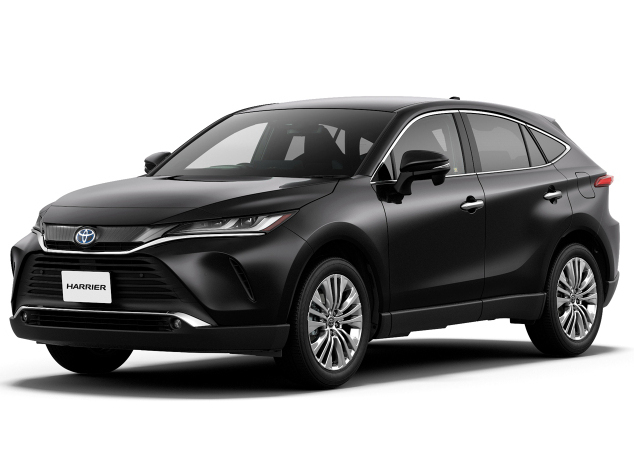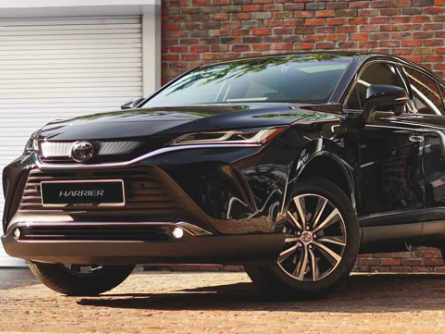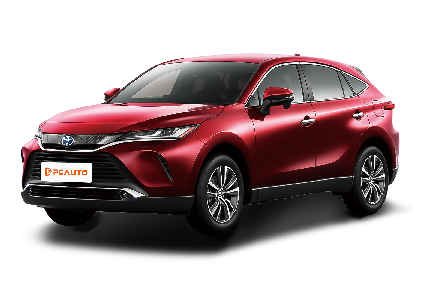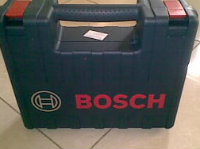Q
What is the Toyota Harrier Size? How Big Is It?
The Toyota Harrier belongs to the D-segment cars, and the dimensions vary slightly among different yearly models. Take the common models in recent years as an example. Generally, the vehicle length is 4,740mm, the width is 1,855mm, the height is 1,660mm, and the wheelbase reaches 2,690mm. Some older models, such as the 2018 version, have a length of 4,725mm, a width of 1,835mm, a height of 1,690mm, and a wheelbase of 2,660mm. This kind of dimension design makes the interior space relatively spacious. With a 5-seater layout, passengers in both the front and rear rows can enjoy a comfortable seating space without feeling cramped. The trunk volume can also meet the loading needs of daily trips or family travels. The large body size, combined with reasonable suspension tuning, such as the front MacPherson independent suspension and the rear double-wishbone independent suspension, ensures driving stability while effectively filtering road bumps and enhancing the comfort of both drivers and passengers.
Special Disclaimer: This content is published by users and does not represent the views or position of PCauto.
Related Q&A
Q
What Segment Does Toyota Harrier Belong to?
The Toyota Harrier is classified as a D-segment luxury SUV in the Malaysian market, positioned between the RAV4 and the Lexus RX. Its main rivals include other Japanese contenders like the Honda CR-V and Mazda CX-5.
Known for its sleek, coupe-inspired SUV design, premium interior materials, and a wide array of tech features, the Harrier is available in Malaysia with either a 2.0L naturally aspirated engine or a 2.5L hybrid powertrain, offering both front-wheel and all-wheel drive configurations.
While it’s marketed in Japan as a “luxury RAV4,” the Harrier is positioned as a more upscale model in Southeast Asia. It boasts larger dimensions and a longer wheelbase than typical C-segment SUVs, delivering interior space that rivals mid-size offerings.
For Malaysian buyers, the Harrier offers the appeal of an imported vehicle with a strong sense of refinement, yet at a more accessible price point than Lexus models. It also retains Toyota’s hallmark reliability and durability. Ideal for families seeking a blend of Japanese luxury and everyday practicality, the hybrid variant benefits from Malaysia’s Energy Efficient Vehicle (EEV) incentives, making it a more cost-effective option in the long run.
Q
What is the Reslae Value of Toyota Harrier?
The Toyota Harrier has shown excellent performance in terms of resale value in the Malaysian used-car market, mainly due to its brand reputation, reliability, and market demand. According to industry observations, Harriers that are 3 to 5 years old usually retain 60% to 70% of their original price. The specific performance depends on factors such as the vehicle's condition, mileage, configuration version, and maintenance records.
As a luxury SUV, the Harrier remains popular in the used-car market thanks to its stylish design, comfortable interior, and hybrid options (such as the Hybrid version). In particular, the third-generation models launched after 2017 have enhanced handling and safety features by being built on the TNGA platform, further strengthening its advantage in terms of resale value. It's worth noting that the hybrid version may have even greater potential for maintaining its value in Malaysia, where fuel prices are relatively high, because of its better fuel economy.
It is recommended that car owners have their vehicles regularly serviced at authorized service centers and keep complete maintenance records, which can significantly increase the resale value. Additionally, Malaysian consumers generally prefer locally assembled (CKD) models. So, there might be a slight difference in the residual value of the imported (CBU) Harriers, but the overall difference is not significant.
When getting to know the market conditions, you can refer to the quotes of similar models on local used-car platforms like Carlist or Mudah. At the same time, pay attention to the pricing standards of Toyota's official certified used-car program (Toyota Sure). These channels can provide more accurate references for residual value assessment.
Q
What is the engine displacement of the Toyota Harrier?
The Toyota Harrier comes in different models with varying displacements. Commonly, there are models with a 2.0L displacement, and the corresponding engine displacements are 1987mL or 1998mL. For example, models like the 2023 Toyota Harrier 2.0 Luxury and the 2023 Toyota Harrier 2.0 Luxury SE all have a displacement of 1987mL; the displacements of the 2018 Toyota Harrier 2.0T Premium and the 2018 Toyota Harrier 2.0T Luxury are 1998mL. CC is the abbreviation for cubic centimeter, which is equivalent to milliliters (mL) in the automotive field. So, the engines of these 2.0L-displacement Toyota Harriers are 1987CC or 1998CC. Additionally, there are reports that the next-generation models may be the first to be equipped with a newly developed 1.5-liter (1500CC) engine, and it will offer both Hybrid gasoline - electric and PHEV plug-in hybrid options.
Q
What kind of engine does the Toyota Harrier have?
The Toyota Harrier offers a range of engine options to suit different driving needs. Some models are equipped with a 2.0-liter naturally aspirated (NA) inline-4 engine. For example, the 2023 version delivers 173 PS, 127.2 kW at 6600 rpm, and 203 Nm of torque at 4900 rpm.
A turbocharged 2.0-liter engine was also previously available, producing up to 231 PS, with peak power at 5200 rpm and peak torque starting as low as 1650 rpm.
Depending on the engine variant, the Harrier is paired with either a CVT or automatic transmission, and most models feature front-wheel drive. These engine configurations offer a balance between everyday comfort and responsive performance to meet the preferences of a wide range of drivers.
Q
What is the Gearbox Type of Toyota Harrier?
The Toyota Harrier offers two types of transmissions in the Malaysian market, depending on the powertrain. Petrol-powered models are typically equipped with a Direct Shift-CVT, which combines the smoothness of a traditional CVT with simulated gear shifts for more responsive acceleration. Notably, it uses a physical first gear for better low-speed performance, reducing the rubber-band effect often associated with conventional CVTs.
Hybrid variants, on the other hand, feature an e-CVT, an electronically controlled continuously variable transmission optimized for hybrid systems. It uses a planetary gear set to deliver efficient power distribution and prioritize fuel economy.
Both transmission types have been locally tuned to suit Malaysia’s hot and humid climate, ensuring durability and smooth operation. Toyota-authorized service centers provide professional maintenance support, and regular checks of transmission fluid are recommended to maintain optimal performance.
For buyers, the choice depends on driving habits: the hybrid's e-CVT is ideal for daily urban commuting and fuel savings, while the petrol model’s Direct Shift-CVT offers a more dynamic driving experience.
Q
What is the PCD Size of Toyota Harrier?
The PCD (Pitch Circle Diameter) of the Toyota Harrier is typically 5x114.3mm. This means that the diameter of the circle formed by the five bolt holes on the wheel hub is 114.3mm. This specification is common in many Toyota models, including some Camry and RAV4 models. It is suitable for wheels with a center bore diameter of 60.1mm, and the bolt thread specification is generally M12x1.5.
For Malaysian car owners, when choosing to modify wheels, in addition to the PCD, they also need to pay attention to whether the offset value (ET value) and center bore size of the wheels match those of the original vehicle to ensure driving safety and avoid vibration problems. The road conditions in Malaysia are variable. It is recommended to choose lightweight and high - strength wheel materials, such as aluminum alloy, which can not only improve handling but also adapt to the local climate.
If you need to replace the wheels, you can give priority to products certified by JWL or VIA. This type of certification can ensure that the wheels meet international safety standards. At the same time, it is recommended to have them installed in a professional shop and perform dynamic balance adjustment to extend the tire life and ensure driving stability.
Q
Does Toyota Harrier Support Apple Carplay?
The Toyota Harrier does come with Apple CarPlay functionality in some models and model years, depending on the vehicle's configuration and release year. For instance, some versions of the Harrier launched in 2020 and later support this feature in the Malaysian market, allowing users to seamlessly connect their iPhones to the car's infotainment system and use apps like navigation and music. Malaysian consumers should check the specifications of the vehicle's infotainment system when making a purchase, as different versions may vary. The entry - level models might not have it as standard, but it can be added through a later upgrade.
Moreover, the addition of Apple CarPlay has significantly enhanced the driving experience, especially for users who rely on their phone's ecosystem. Toyota has also been gradually rolling out this technology across multiple models in recent years, such as the Corolla Cross and RAV4, which shows the brand's emphasis on meeting the demand for smart connectivity.
If you're thinking about buying a used or a new Harrier, it's advisable to directly inquire with local dealers about the specific configurations or take a test drive to experience the system's smooth operation, ensuring it meets your personal usage habits.
Q
What is the Tyre Brand of Toyota Harrier?
The factory-equipped tire brand on the Toyota Harrier in Malaysia varies by model year and trim level. Common OEM options include reputable international brands such as Bridgestone, Dunlop, and Yokohama which are all known for their durability and wet-weather performance, which are well-suited to Malaysia’s humid, rainy climate.
For example, the 2023 Harrier’s higher trims are often fitted with Bridgestone Alenza tires, which prioritize quietness and ride comfort. Entry-level models may come with more budget-friendly options such as the Dunlop PT3.
Harrier owners are advised to check tire pressure and tread depth regularly, especially ahead of the rainy season, to ensure optimal drainage and grip. When replacing tires, refer to the original specification (e.g., 235/55 R19). Alternatives such as the Michelin Primacy 4 or Continental UC6 are popular for their balanced performance in comfort and handling. However, mixing different tire brands on the same vehicle is not recommended, as it may affect driving dynamics.
Malaysia’s hot and wet climate can accelerate rubber aging. As a general guideline, tires should be inspected and possibly replaced every five years or 60,000 km. For vehicles parked for extended periods, avoid uneven pressure that could lead to flat spots or sidewall deformation.
Q
Is Toyota Harrier a Good Car? Learn the Pros and Cons Here!
The Toyota Harrier is a popular SUV in the Malaysian market. Its advantages include a spacious and comfortable interior, excellent fuel economy, and the reliable quality that Toyota is known for. It's especially suitable for family use or long-distance driving. The 2.0L and 2.5L hybrid versions offer diverse power options to meet different driving needs. The hybrid versions are particularly fuel-efficient when driving in the city, making them a great fit for the common congested traffic conditions in Malaysia.
In addition, the Harrier comes with comprehensive safety features. The Toyota Safety Sense system is standard, which includes functions like pre-collision warning and lane-keeping assist, enhancing driving safety.
However, the Harrier has its drawbacks. Its price is relatively high, especially for the hybrid versions, and the maintenance costs are slightly higher than some of its competitors in the same class. Also, the space in the third-row seats is rather cramped, not very suitable for adults on long-term rides.
For Malaysian consumers, if they have a sufficient budget and value brand reputation and fuel efficiency, the Harrier is a good choice. But if they are looking for better value for money or more spacious seven-seat accommodation, they can also consider other models in the same class. Overall, the Harrier offers a well-balanced performance in terms of quality, comfort, and technology, making it a worthy SUV to consider.
Q
What is the Width of Toyota Harrier?
The body width of the Toyota Harrier is 1,890 millimeters, making it one of the wider designs among SUVs in its class. This allows for generous lateral space inside the cabin, enhancing passenger comfort, especially for Malaysian families during long-distance travel. The Harrier's wide body also contributes to greater driving stability. Together with its streamlined shape, it reduces wind resistance and improves fuel efficiency.
The broader body also enables a more flexible interior layout. For example, the rear seats can be reclined, and the trunk offers a generous 487 liters of space, which expands to 1,278 liters when the seats are folded down. This makes it ideal for weekend getaways or shopping trips, both popular activities among Malaysian drivers.
Although the Harrier’s width slightly exceeds 1.8 meters, it still fits comfortably into standard Malaysian parking spaces, which are typically around 2.5 meters wide. Daily use remains convenient. The vehicle’s dimensions strike a strong balance between spacious practicality and agile handling. Built on the TNGA-K platform, the Harrier features enhanced chassis rigidity. This solid foundation ensures the wide body maintains precise steering control even through curves, making it well suited to Malaysia’s diverse road conditions, from mountainous terrain to city streets.
Latest Q&A
Q
What are the changes to the 2025 Porsche Cayenne Coupe?
There are changes in multiple aspects for the 2025 Porsche Cayenne Coupe. In terms of appearance, the front air intake grille is larger, and LED headlights come as standard across the range. You can also opt for the Porsche Dynamic Light System to achieve various lighting modes. The overall body dimensions have increased. The length has grown by 48 millimeters, the width by 11 millimeters, the height by 6 millimeters, and the wheelbase by 4 centimeters. The details at the rear have been upgraded. The taillight clusters are slimmer and feature all - LED light sources.
The interior has undergone a brand - new transformation. The buttons on the center console are arranged in a more orderly manner. In the power system, there is a new 8 - speed Tiptronic S transmission and a new chassis system. In addition, it is equipped with wider rear tires and rear - axle steering for the first time, enhancing both sportiness and comfort.
The locally assembled Cayenne S E - Hybrid Coupe is based on the redesigned third - generation (E3) Cayenne. It uses a new PHEV system with a combined output power of 519 PS. It can accelerate from 0 to 100 km/h in just 4.7 seconds, has a pure - electric range of up to 90 kilometers, and is also equipped with Porsche Active Suspension Management and a double - chamber, double - valve air suspension.
The in - car configuration has also been upgraded, such as the adoption of a new 12.6 - inch curved digital instrument display and an enhanced ADAS package.
Q
What engine is in the Porsche Cayenne Coupe?
The Porsche Cayenne Coupe offers a variety of powertrain options in the Malaysian market, including efficient turbocharged engines and plug - in hybrid systems. The specific configuration depends on the model version. The base - model Cayenne Coupe is powered by a 3.0 - liter V6 turbocharged engine, which outputs 340 horsepower. The Cayenne S Coupe, on the other hand, features a 2.9 - liter V6 twin - turbocharged engine that can generate 440 horsepower. The high - performance Cayenne Turbo Coupe is equipped with a 4.0 - liter V8 twin - turbocharged engine with a maximum power of 550 horsepower, demonstrating strong power performance.
In addition, the Cayenne Coupe also offers an E - Hybrid plug - in hybrid version, which combines a 3.0 - liter V6 engine with an electric motor, delivering a combined output of up to 462 horsepower while balancing performance and environmental protection. All these engines are paired with Porsche's 8 - speed Tiptronic S transmission, providing a smooth shifting experience and meeting the dual demands of Malaysian consumers for both the sportiness and comfort of luxury SUVs.
It's worth mentioning that Porsche's engine technology focuses on balancing fuel efficiency and power output. Even the high - performance versions meet strict emission standards, making them suitable for Malaysia's diverse driving environments, whether it's urban commuting or high - speed cruising.
Q
Does the Cayenne Coupe have a sunroof?
Yes, the Porsche Cayenne Coupe comes with a panoramic fixed glass sunroof, which is one of its standard features. It can provide good lighting inside the car and enhance the overall sense of luxury. However, it should be noted that this sunroof cannot be opened like a traditional one. Instead, it has a fixed design. In Malaysia's hot climate, this sunroof actually has certain heat insulation and anti - UV functions, which can reduce the discomfort caused by direct sunlight. If you prefer an openable sunroof, you may need to consider the standard SUV version of the Cayenne, which offers an openable panoramic sunroof in some configurations. Additionally, it's worth mentioning that the roofline of the Cayenne Coupe features a fastback design, which makes its overall shape more sporty but also slightly affects the rear headroom. If you have higher requirements for space, it is recommended that you take a test drive and experience it in person.
Q
Is the Cayenne Coupe bigger than the Macan?
Yes, the Cayenne Coupe is larger than the Macan. The Cayenne Coupe measures 4,918mm in length, 1,983mm in width, and 1,690mm in height, with a wheelbase of 2,895mm. It belongs to the mid - large luxury SUV category. On the other hand, the Macan has dimensions of 4,696mm in length, 1,923mm in width, and 1,624mm in height, and its wheelbase is 2,807mm. It is a mid - size sports SUV.
The larger body size of the Cayenne Coupe results in a more spacious interior. Whether in the front or rear seats, passengers can enjoy more ample headroom and legroom, which enhances the riding comfort. Moreover, the Cayenne Coupe also has a larger trunk volume and stronger loading capacity. If you have high requirements for space, the Cayenne Coupe would be a better choice. However, if you pursue flexible handling, the more compact Macan is more suitable.
Q
What are the variants of Porsche Cayenne Coupe?
The Porsche Cayenne Coupe offers a variety of powertrain and configuration options in the Malaysian market, including the base - model Cayenne Coupe, the more powerful Cayenne S Coupe, and the high - performance Cayenne Turbo Coupe, meeting different driving needs. The base model is equipped with a 3.0 - liter V6 turbocharged engine, delivering 340 horsepower. The Cayenne S Coupe uses a 2.9 - liter V6 twin - turbocharged engine, outputting 440 horsepower. The Cayenne Turbo Coupe is fitted with a 4.0 - liter V8 twin - turbocharged engine, which can reach a maximum output of 550 horsepower and can accelerate from 0 - 100 km/h in just 3.9 seconds.
In addition, the Cayenne Coupe also offers an E - Hybrid plug - in hybrid version. Combining a 3.0 - liter V6 engine with an electric motor, it has a combined output of 462 horsepower, balancing performance and environmental friendliness. All models come standard with an adaptive air suspension and the Sport Chrono package to enhance handling and comfort. You can also choose to install a lightweight sports package or luxury interior configurations.
For Malaysian consumers, the Cayenne Coupe not only features a sporty fastback design but also has the practicality of an SUV, making it suitable for owners who seek a balance between a sporty style and daily driving. Porsche's official dealers in Malaysia provide comprehensive after - sales services and warranty plans to ensure that owners enjoy a high - quality car - owning experience.
View MoreRelated News

Toyota Harrier: The Perfect Blend of Fuel Efficiency and Premium Comfort
JamesApr 23, 2025

The 2023 Toyota Harrier is priced at RM 274,000, 2.0NA+CVT
LienJul 3, 2024

Toyota Confidently Raises 2025 Global Production Target to 10 Million Units
LienAug 5, 2025

Toyota's global sales exceeded 5.159 million units in the first half of 2025, ranking first in the world for six consecutive years.
JamesAug 1, 2025

Toyota's Struggles with Digital Shift Delay Next-Gen EV Launch
LienJul 29, 2025
View More


















Pros
Cons